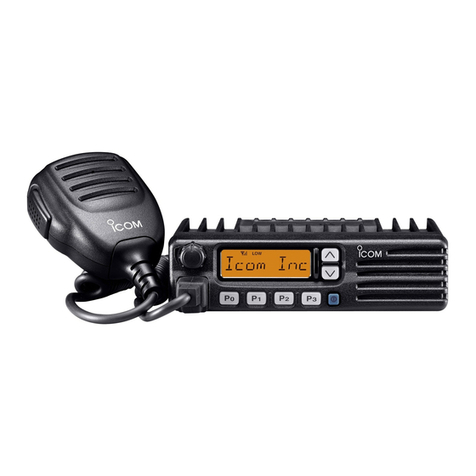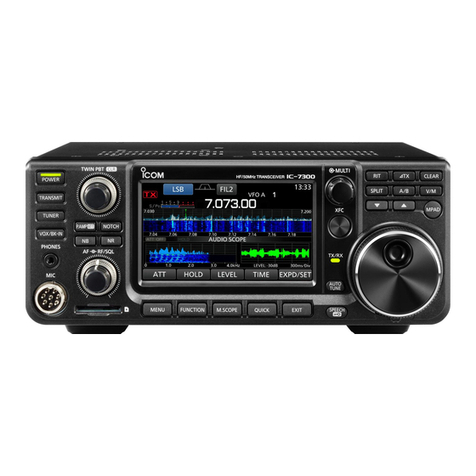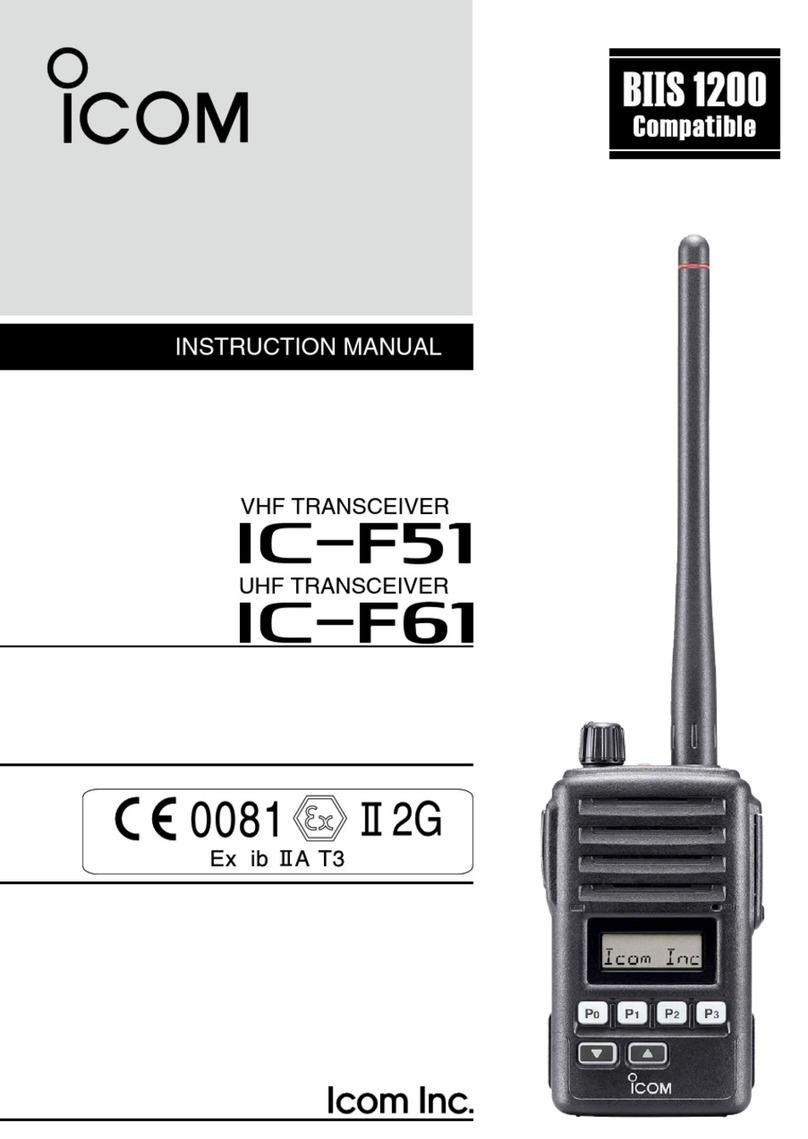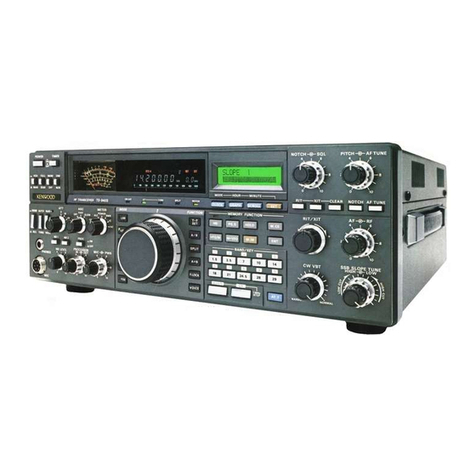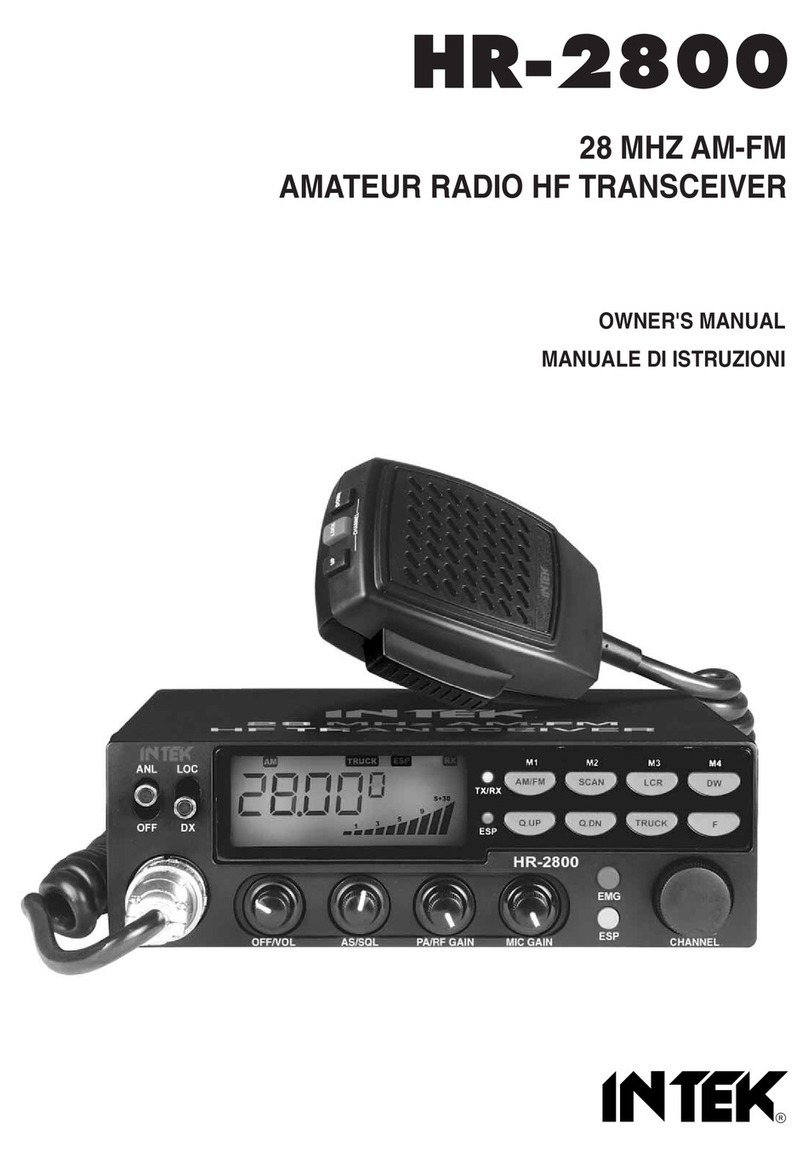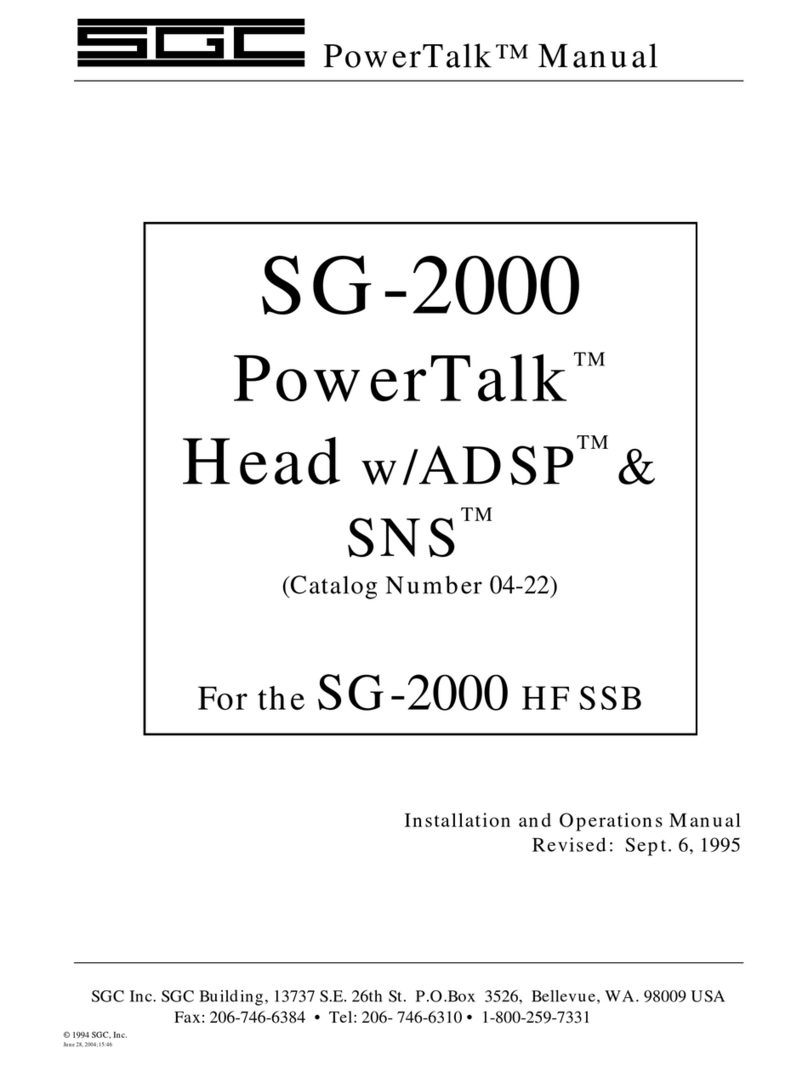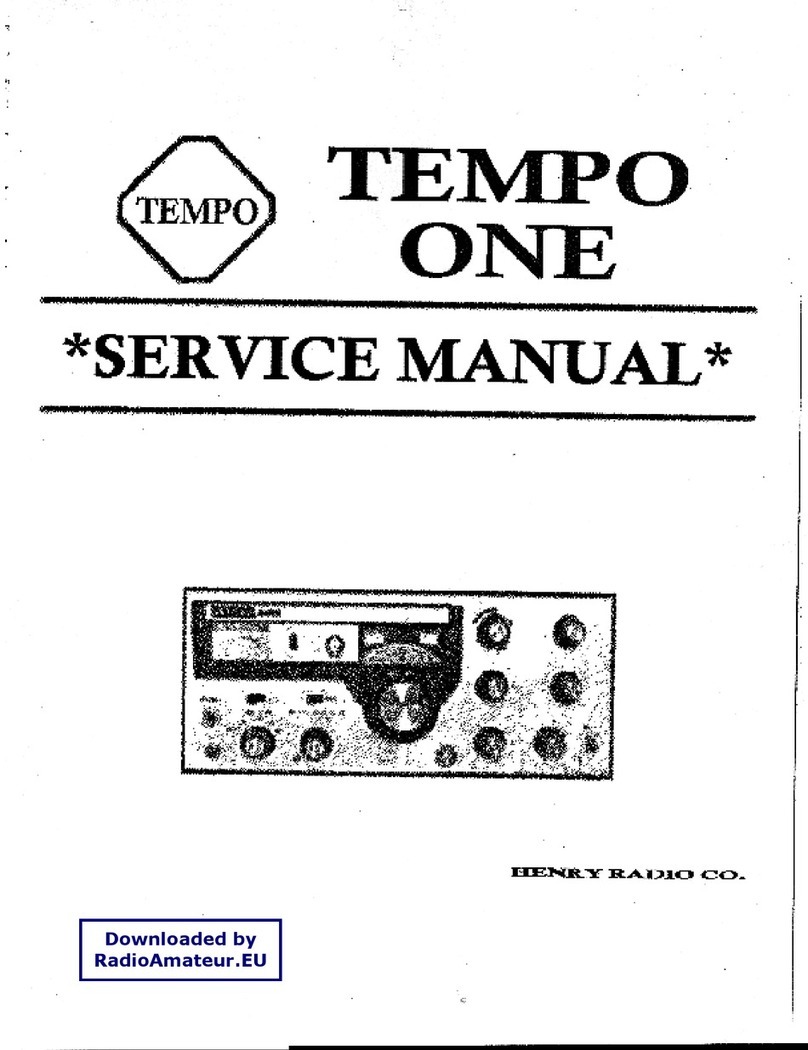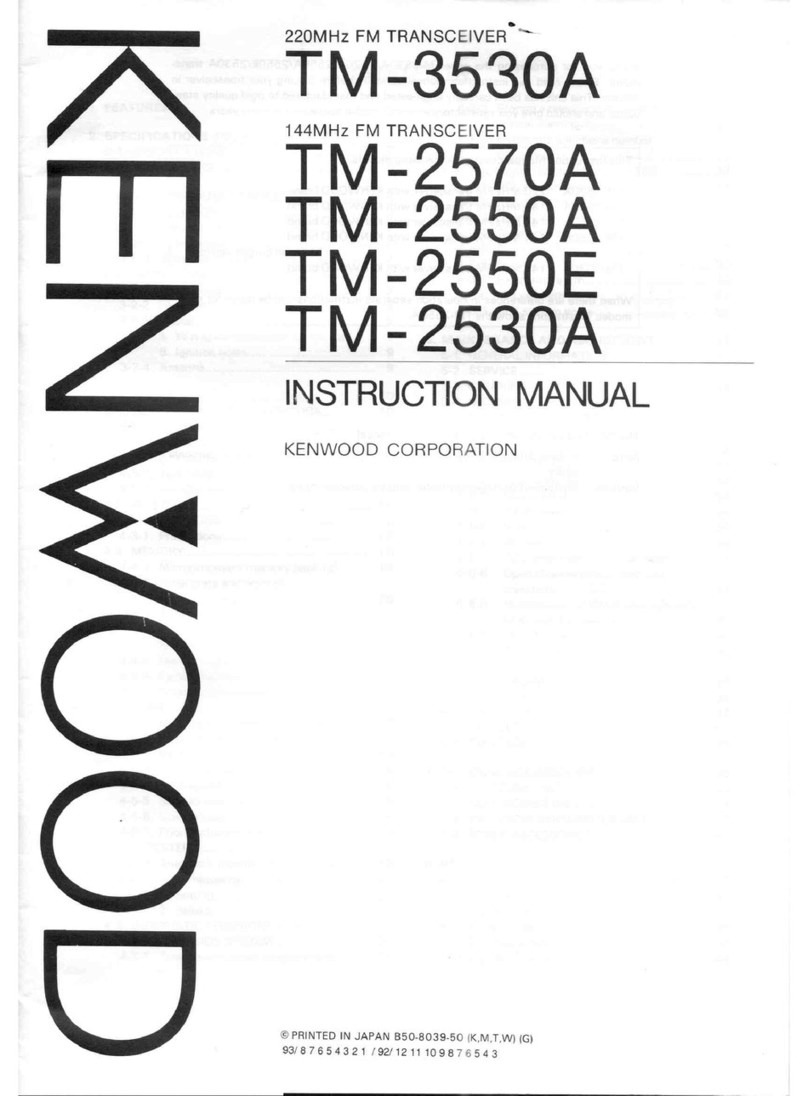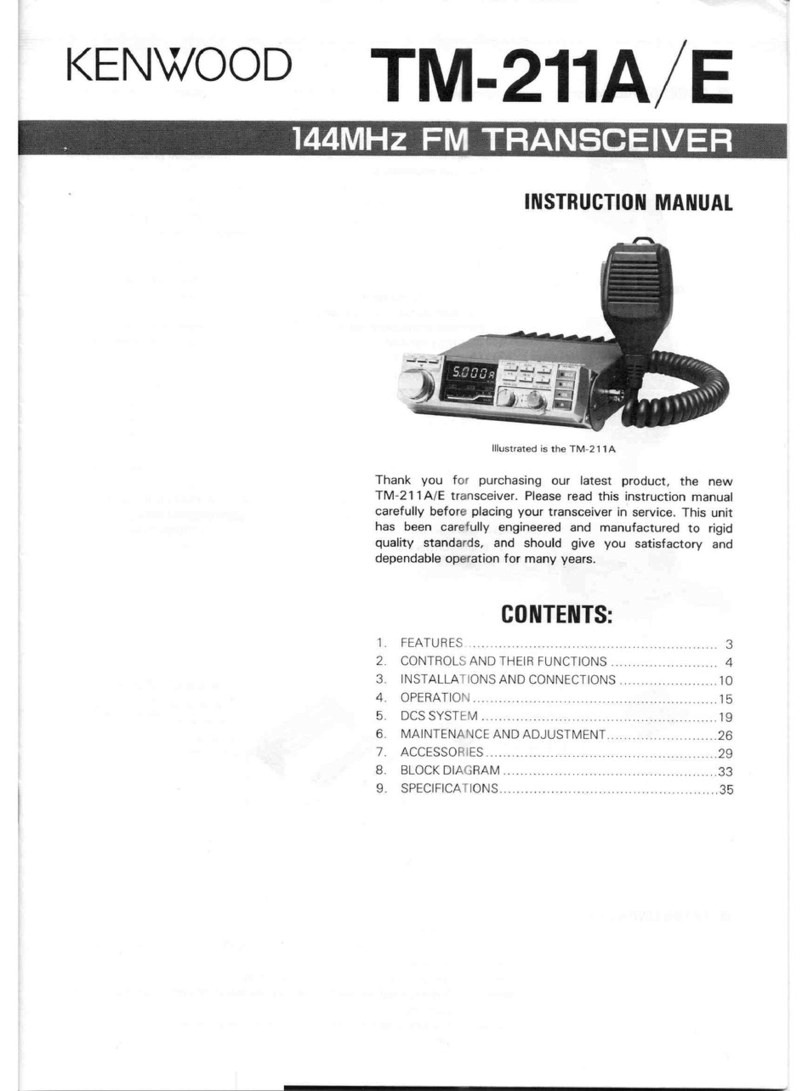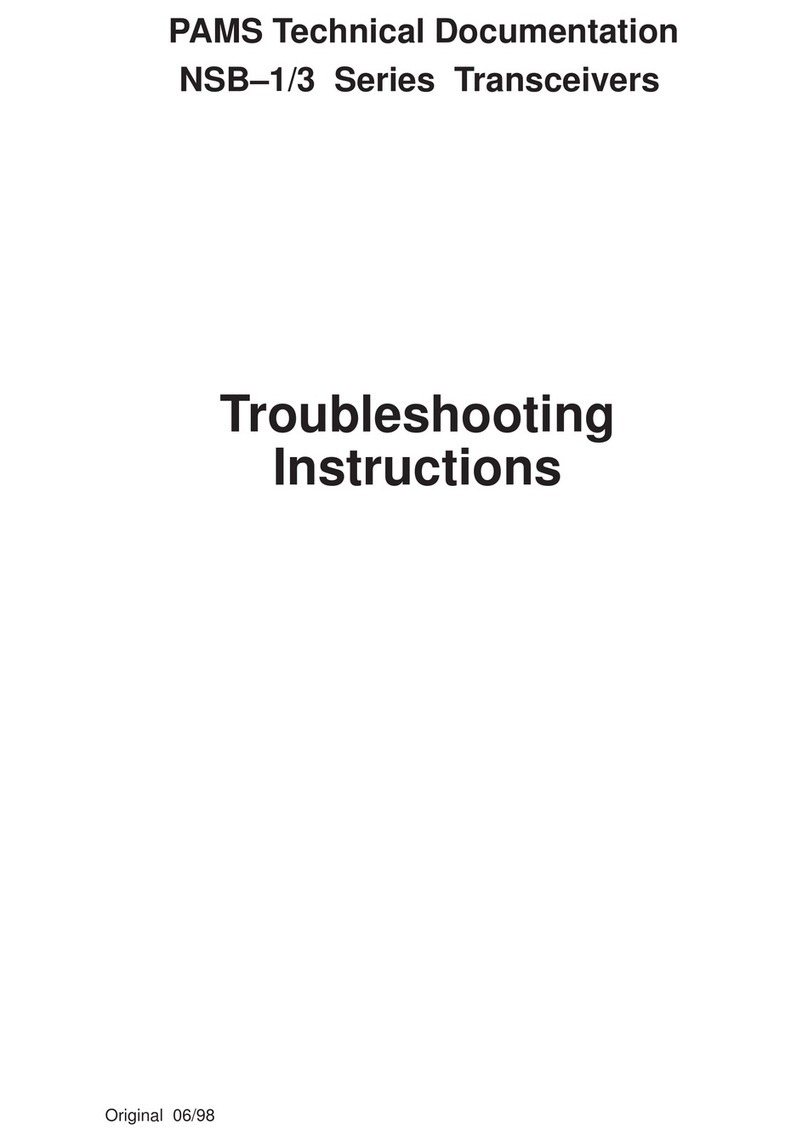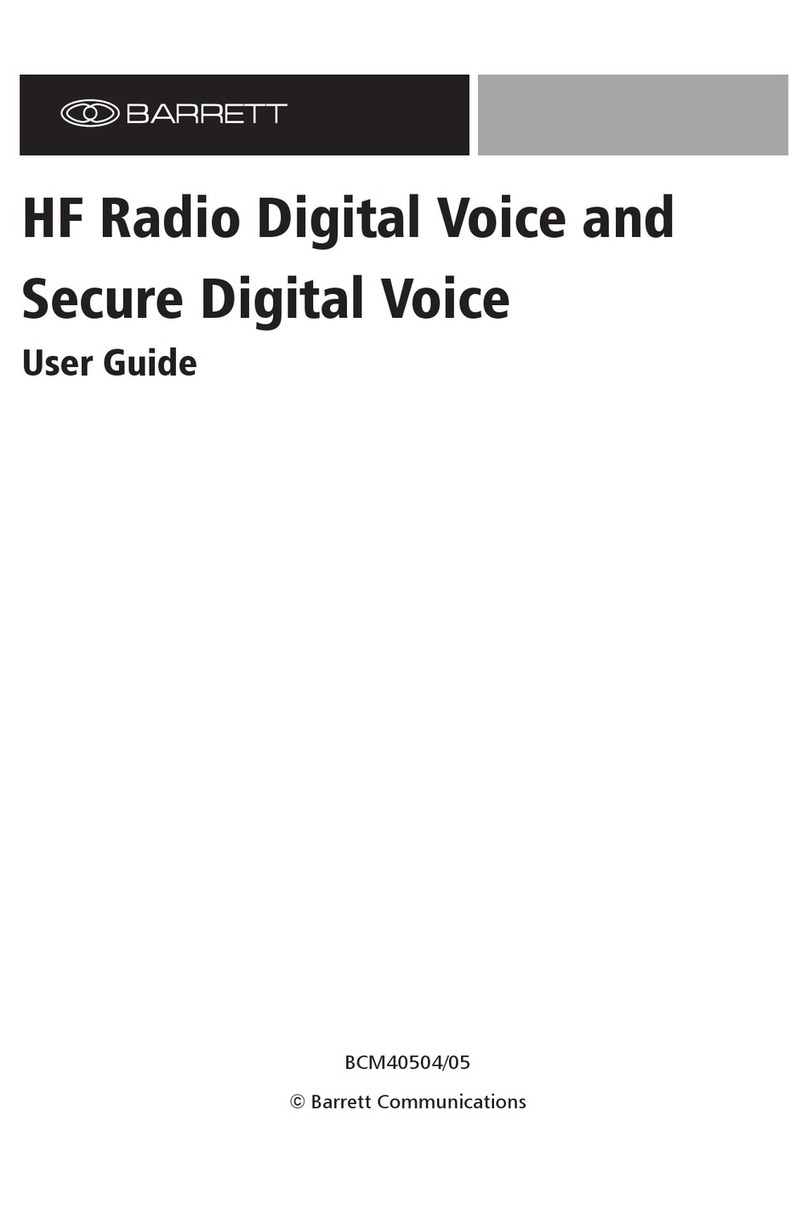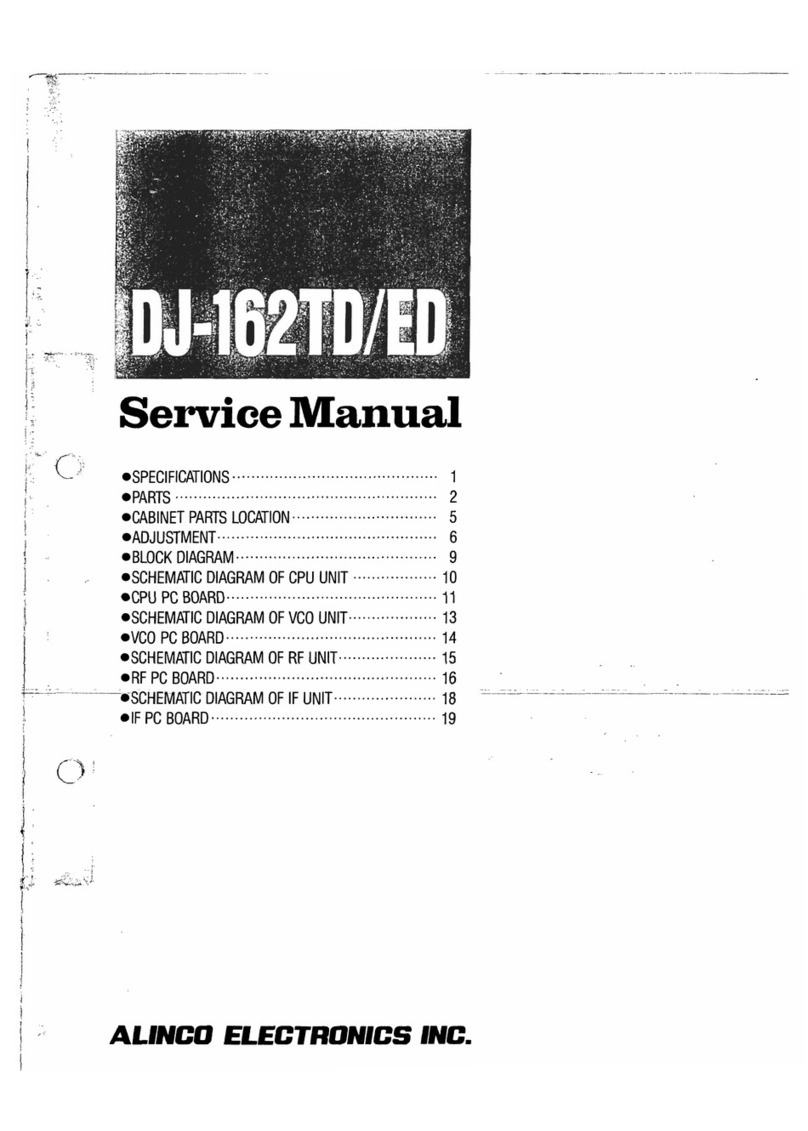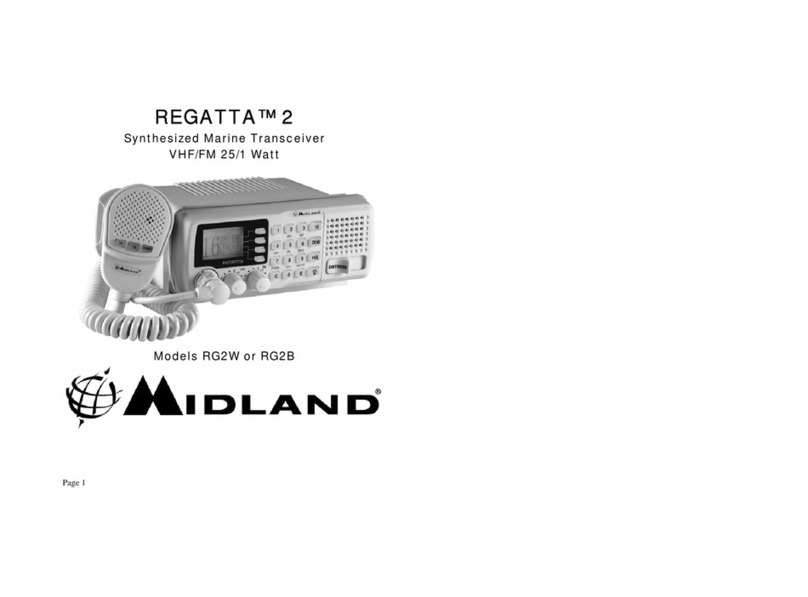Icom IC-T70A User manual

S-14623XZ-C1
Feb. 2010
VHF/UHF DUAL BAND FM TRANSCEIVER
All manuals and user guides at all-guides.com
all-guides.com

This service manual describes the latest technical
information for the IC-T70A and IC-T70E VHF/UHF DUAL
BAND FM TRANSCEIVER, at the time of publication.
NEVER connect the transceiver to an AC outlet or to a DC
power supply that uses more than the specified voltage.
This will ruin the transceiver.
DO NOT expose the transceiver to rain, snow or any liquids.
DO NOT reverse the polarities of the power supply when
connecting the transceiver.
DO NOT apply an RF signal of more than 20 dBm (100 mW) to
the antenna connector. This could damage the transceiver’s
front-end.
To upgrade quality, any electrical or mechanical parts
and internal circuits are subject to change without notice
or obligation.
MODEL VERSION SUPPLIED
BATTERY PACK
SUPPLIED
CHARGER
IC-T70A
TPE
BP-264
BC-167SA
USA
KOR –
AUS BC-167SV
EXP BC-167SA
EXP-01 BC-167SD
IC-T70E
EUR BC-167SD
UK –
CHN –
RSP BP-264 BC-167SD
Be sure to include the following four points when ordering
replacement parts:
1. 10-digit Icom part number
2. Component name
3. Equipment model name and unit name
4. Quantity required
<ORDER EXAMPLE>
1110007320 NJM2591V IC-T70A MAIN UNIT 2 pieces
8310075430 3253 WINDOW PLATE IC-T70E CHASSIS 10 pieces
Addresses are provided on the inside back cover for your
convenience.
ORDERING PARTS
1. Make sure that the problem is internal before
disassembling the transceiver.
2. DO NOT open the transceiver until the transceiver is
disconnected from its power source.
3. DO NOT force any of the variable components. Turn
them slowly and smoothly.
4. DO NOT short any circuits or electronic parts. An
insulated tuning tool MUST be used for all adjustments.
5. DO NOT keep power ON for a long time when the
transceiver is defective.
6. DO NOT transmit power into a Standard Signal
Generator or a Sweep Generator.
7. ALWAYS connect a 50 dB to 60 dB attenuator between
the transceiver and a Deviation Meter or Spectrum
Analyzer, when using such test equipment.
8. READ the instructions of the test equipment throughly
before connecting it to the transceiver.
REPAIR NOTES
INTRODUCTION
CAUTION
(IC-T70A)
UNIT ABBREVIATIONS:
AC: ACCESSORY
CH: CHASSIS
M: MAIN UNIT
Icom, Icom Inc. and the Icom logo are registered trademarks of Icom Incorporated (Japan) in Japan, the United States, the
United Kingdom, Germany, France, Spain, Russia and/or other countries.
All manuals and user guides at all-guides.com

TABLE OF CONTENTS
SECTION 1 SPECIFICATIONS
SECTION 2 INSIDE VIEWS
SECTION 3 DISASSEMBLY INSTRUCTION
SECTION 4 CIRCUIT DESCRIPITON
4-1 RECEIVER CIRCUITS. . . . . . . . . . . . . . . . . . . . . . . . . . . . . . . . . . . . . . . . . . . . . . . . . . . . . . . . 4-1
4-2 TRANSMITTER CIRCUITS . . . . . . . . . . . . . . . . . . . . . . . . . . . . . . . . . . . . . . . . . . . . . . . . . . . . 4-2
4-3 FREQUENCY SYNTHESIZER CIRCUITS . . . . . . . . . . . . . . . . . . . . . . . . . . . . . . . . . . . . . . . . 4-3
4-4 CPU PORT ALLOCATION . . . . . . . . . . . . . . . . . . . . . . . . . . . . . . . . . . . . . . . . . . . . . . . . . . . . . 4-4
4-5 VOLTAGE BLOCK DIAGRAM . . . . . . . . . . . . . . . . . . . . . . . . . . . . . . . . . . . . . . . . . . . . . . . . . . 4-4
SECTION 5 ADJUSTMENT PROCEDURES
5-1 PREPARATION . . . . . . . . . . . . . . . . . . . . . . . . . . . . . . . . . . . . . . . . . . . . . . . . . . . . . . . . . . . . . 5-1
5-2 TRANSMIT ADJUSTMENTS . . . . . . . . . . . . . . . . . . . . . . . . . . . . . . . . . . . . . . . . . . . . . . . . . . . 5-3
5-3 FREQUENCY ADJUSTMENTS. . . . . . . . . . . . . . . . . . . . . . . . . . . . . . . . . . . . . . . . . . . . . . . . . 5-7
5-4 MODURATION ADJUSTMENTS . . . . . . . . . . . . . . . . . . . . . . . . . . . . . . . . . . . . . . . . . . . . . . . . 5-8
5-5 RECEIVE ADJUSTMENTS . . . . . . . . . . . . . . . . . . . . . . . . . . . . . . . . . . . . . . . . . . . . . . . . . . . . 5-11
SECTION 6 PARTS LIST
SECTION 7 MECHANICAL PARTS
SECTION 8 BOARD LAYOUTS
SECTION 9 BLOCK DIAGRAM
SECTION 10 VOLTAGE DIAGRAM
All manuals and user guides at all-guides.com

1 - 1
SECTION 1
.
SPECIFICATIONS
• Frequency coverage : (unit: MHz)
Version TX RX
EUR, KOR 144–146, 430–440 144–146, 430–440
UK, RSP 144–146, 430–440 136–174*1,400–479*2
U.S.A. 136–174*3,400–479*4136–174*3,400–479*4
TPE 144–146, 430–432 144–146, 430–432
AUS 144–148, 420–450*2136–174*3,400–479*2
CHN, EXP 136–174*3,400–470*2136–174*3,400–479*2
*
1Guaranteed 144–146 MHz only, *2Guaranteed 430–440 MHz only,
*
3Guaranteed 144–148 MHz only, *4Guaranteed 440–450 MHz only
• Mode :
FM, FN-N
• No. of memory channels : 302
(incl. 50 scan edges and 2 call channels)
• Usable temp. range : –20°C to +60°C; –4°F to +140°F
• Tuning steps : 5, 10, 12.5, 15, 20, 25, 30, 50, 100,
125 and 200 kHz
• Frequency stability :
±2.5 ppm (–20°C to +60°C; –4°F to +140°F)
• Power supply : 10.0–16.0 V DC for external DC power,
or specified Icom’s battery pack
• Current drain (at 7.2 V DC) :
TX High(typical) VHF 1.7 A, UHF 2.1 A
Mid. (typical) VHF 1.2 A, UHF 1.5 A
Low (typical) VHF 0.6 A, UHF 0.8 A
Rx Max. output Less than 450 mA (Internal speaker)
Less than 300 mA (External speaker)
Power save Less than 40 mA (Duty 1:8)
standby Less than 90 mA
• Antenna connector : SMA (50 :)
• Dimensions : 58(W)×111(H)×30(D) mm;
(projections not included) 2
9⁄32(W)×43⁄8(H)×13⁄16(D) in
• Weight (approx.) : 380 g; 13.4 oz (with antenna and BP-264)
• Modulation system : Variable reactance freq. modulation
• Output power (at 7.2 V DC) : (typical)
High 5.0 W, Mid. 2.5 W, Low 0.5 W
• Max. frequency deviation : ±5.0 kHz (FM wide: approx.)
±2.5 kHz (FM narrow: approx.)
• Spurious emissions : Less than –60 dBc at High/Mid.
Less than –13 dBm at Low
• Ext. mic. impedance : 2.2 k:
DReceiver
• Receive system : Double-conversion superheterodyne
• Intermediate frequencies : 1st 46.35 MHz, 2nd 450 kHz
• Sensitivity (except spurious points, 1 kHz/3.5 kHz Dev.; 12 dB SINAD) :
Guaranteed freq. range Less than 0.18 μV
Other freq. range Less than 0.32 μV
• Squelch Sensitivity (except spurious points, 1 kHz/3.5 kHz Dev.) :
Guaranteed range Less than 0.18 μV
Other frequency range Less than 0.32 μV
• Audio output power : (at 10% distortion/7.2 V DC)
Internal speaker More than 700 mW with a 16 :load
External speaker More than 400 mW with an 8 :load
• Selectivity :
(at CH spacing 20 kHz/in the amateur bands)
FM (Wide) More than 60 dB
FM (Narrow) More than 60 dB
• Ext. speaker connector : 3-conductor 3.5(d) mm; (1⁄8˝)/8 :
• Spurious and image rejection ratio (in guaranteed freq. range) :
More than 60 dB
All stated specifications are subject to change without notice or obligation.
All stated specifications are subject to change without notice or obligation.
PGENERAL PTRANSMITTER
PRECEIVER
All manuals and user guides at all-guides.com

2 - 1
SECTION 2
.
INSIDE VIEWS
• MAIN UNIT
(TOP VIEW)
5 V REGULATOR (5VS line)
(Q108)
5 V REGULATOR (BTL5V line)
(Q6)
MIC AMP/VOX AMP
(IC800)
MIC MUTE SW
(IC909)
AF AMP/BPF/LPF
(IC2)
RX AF MUTE SW
(IC904)
TONE FILTER
(Q10)
AF BPF
(Q8)
YGR AMP
(Q502)
TX DRIVE AMP
(Q503)
TX PWR AMP
(Q507)
PLL IC
(IC305)
MODULATION MUTE SW
(Q307)
DC SW (VCC line)
(Q100)
5 V REGULATOR (T5 line)
(Q200)
D/A CONVERTER
(IC5)
5 V REGULATOR (R5 line)
(Q202)
TX AMP BIAS CONTROLLER
(IC500)
3.6 V REGULATOR
(IC304)
TCXO
(X300)
TX AMP CURRENT DETECTER
(IC102)
All manuals and user guides at all-guides.com

2 - 2
• MAIN UNIT
(BOTTOM VIEW)
RF AMP (UHF band)
(Q511)
RF AMP (VHF band)
(Q505)
TX AMP BIAS CONTROLLER
(IC501)
VCO
CPU RESET IC
(IC200)
POWER SUPPLY
LINE “BTL5V” SW
(Q5)
IF DEMODULATOR IC
(IC311)
2ND IF FILTER
(FI300)
DISCRIMINATOR
(X301)
ELECTRIC VOLUME
(IC4)
1ST MIXER (UHF band)
(Q509)
TX MUTE SW
(Q504)
DATA LINE BUFFER
(Q11)
POWER SUPPLY
LINE “CHG” SW
(Q101)
MIC LINE SW
(Q7)
1ST IF FILTER
(FI301)
DATA LINE BUFFER
(Q1)
POWER SUPPLY
LINE “5VS” SW
(Q109)
1ST IF MIXER (VHF band)
(Q500)
CPU
(IC907)
5 V REGULATOR (CPU5V line)
(IC101)
EXPANDER
(IC908)
EEPROM
(IC201)
TONE LPF
(Q204)
ANT SW DRIVER
(Q508)
AF POWER AMP
(IC1)
All manuals and user guides at all-guides.com
all-guides.com

3 - 1
SECTION 3
.
DISASSEMBLY INSTRUCTION
1. REMOVING THE CHASSIS
1) Remove the jack cap, ANT nut and 2 knobs.
4)
CAREFULLY lift the chassis out of the FRONT PANEL
and turn it over in order to unplug the speaker wire.
2) Remove 2 screws from the bottom of the CHASSIS.
3) Lift the bottom of the CHASSIS up in the direction
of the arrow.
2. REMOVING THE MAIN UNIT
1) Remove the metal sheet from the top plate.
2) Unsolder the 5 points, and remove the shield plate.
KNOBS
JACK CAP
ANT NUT
Remove with;
“ICOM Driver (Q)”
(8960000370)
FRONT PANEL
SPEAKER
WIRE
CHASSIS
SHIELD PLATE
SCREWS
UNSOLDER
Solder
remover
UNSOLDER
Solder
remover
Top plate Metal sheet
CHASSIS
MAIN UNIT
SCREWS
SCREWS
CHASSIS
LCD
DIAL NUT
TOP PLATE
TOP SEAL
MAIN UNIT
UNSOLDER
Solder
remover
Remove with;
“ICOM Driver (AG)”
(8960000560)
FRONT PANEL
SCREWS
CHASSIS
Suction lifter
• Part name : EA950R-2
• Manufacture : ESCO CO.LTD
BE CAREFUL to not pull out the speaker wire when
separating the CHASSIS and the FRONT PANEL.
3) Remove the 2 screws from the MAIN UNIT.
4) Remove the top seal, dial nut and top plate from the
chassis.
5) Unsolder the 2 points.
6) Remove the 4 screws, and remove the MAIN UNIT
from the chassis.
For easy separation of the CHASSIS
Use a suction lifter to lift the bottom of the CHASSIS up.
All manuals and user guides at all-guides.com

4 - 1
• DUPLEXER AND RF CIRCUITS
• 1ST IF CIRCUITS
SECTION 4
.
CIRCUIT DESCRIPTION
LPF
ANT
SW
ANT
SW HPF
RF
AMP
BPF
RF
AMP BPFBPF
BPF
LPFLPF
LPF
400-479 MHz
D510, D511
Q511
VHF (136-174 MHz)
D512,D515,D519
D502,D503,D504
D523
UHF(400-479 MHz)
To the 1st IF circuits
To the 1st IF circuits
Q505
D509,
D506,
UHF TX circuits
VHF TX circuits
D524
136-174 MHz
Duplexer
BPF
XTALIF
AMP
VHF
LO signal
UHF
LO signal
Q509
Q500 From the VH
F
RF circuits
From the UH
F
RF circuits
VHF 1st mixer
UHF 1st mixer
Q318
46.35MHz
To the
2nd IF circuits LIMIT
FI301
D313
4-1 RECEIVER CIRCUITS
DUPLEXER
The VHF/UHF RX signal from the antenna is separated by
frequency in the duplexer. The VHF signal is passed through
the LPF, which eliminates the unwanted VHF and above
frequencies, and the UHF signal is passed through the HPF,
which eliminates the frequencies below UHF.
RF CIRCUITS
• VHF BAND
The VHF RX signal from the duplexer is passed through
the LPF, ANT SW (D509–D511) and BPF, and then applied
to the low-noise RF AMP (Q505). The amplified signal
is filtered by the 3-stage tuned BPF (D502–D504) to
thoroughly eliminate unwanted frequencies. (e.g. the image
frequencies, etc.). The filtered RX signal is then applied to
the 1st IF circuits.
• UHF BAND
The UHF RX signal from the duplexer is passed through two
LPFs, ANT SW (D506, D524) and tuned BPF (D523), and
then applied to the low-noise RF AMP (Q511). The amplified
signal is filtered by the tuned BPF (D512, D515, D519) to
thoroughly eliminate unwanted frequencies. The filtered RX
signal is then applied to the 1st IF circuits.
1ST IF CIRCUITS
The signal from the RF circuits is applied to the 1st IF
mixer (VHF band; Q500/UHF band; Q509) and mixed with
the 1st LO signal from the VHF/UHF VCO, resulting in the
46.35 MHz 1st IF signal. The 1st IF signal is filtered by the
crystal filter (FI301), amplified by the 1st IF AMP (Q318),
and then applied to the 2nd IF circuits through the limiter
(D313).
All manuals and user guides at all-guides.com

4 - 2
• 2ND IF CIRCUITS
• RX AF CIRCUITS
BPF
CERAMIC
IF DEMODULATOR IC
DISCRI
FI300
IC313
X301
TCXO
X300
15.3 MHz 45.9 MHz
Q305
From the
1st IF circuits
To the AF circuits
X3
Ext. speaker jack
Int. speaker
AF
AMP LPFD/A BPF SW
MUTE
From the
demodulator circuit
IC4
IC1 Q8 IC904
2ND IF AND DEMODULATOR CIRCUITS
The signal from the 1st IF circuits is applied to the IF
demodulator IC(IC313), which contains the 2nd IF mixer,
2nd IF AMP, FM detector, etc. in its package.
The 1st IF signal is applied to the 2nd IF mixer and mixed
with the 2nd LO signal, resulting in the 450 kHz 2nd IF
signal. The 2nd LO signal is produced by tripling the
15.3 MHz reference frequency signal that is generated by
the reference frequency oscillator (TCXO; X300).
The 2nd IF signal is filtered by the crystal filter (FI300) to
eliminate unwanted signals, and amplified by the 2nd IF
AMP, and then demodulated by the quadrature detector
circuit, which employs a discriminator (X301) as the phase
shifter.
The demodulated AF signal is applied to the RX AF circuits.
RX AF CIRCUITS
The demodulated AF signal from the IF demodulator IC
(IC313) is passed through the mute SW (IC904), LPF and
AF filter (Q8), which de-emphasizes the signal to obtain
–6 dB/oct of frequency response. The de-emphasized AF
signal is adjusted in level by the D/A converter (IC4), and
then applied to the AF power AMP (IC1) to obtain the AF
output signal.
The amplified AF signal is applied to the internal or external
speaker.
4-2 TRANSMITTER CIRCUITS
TX AF CIRCUITS
The audio signal from the internal or external microphone
(MIC signal) is passed through the MIC gain VR (IC4) which
adjusts the microphone sensitivity, and then applied to the
MIC AMP (IC800B).
The amplified MIC signal is passed through the MIC mute
SW (IC909), HPF, BPF (IC2A) and LPF (IC2D). The filtered
MIC signal is applied to the D/A converter (IC5) to be
adjusted in level (=deviation).
The level-adjusted MIC signal is applied to the modulation
circuit as the modulation signal.
Int. MIC
Ext. MIC JACK
HPF
LPF
BPF
MIC
MUTE
MIC
AMP
To the modulation circuit
MOD
IC5
IC2D
IC2A
D/A
converter
MIC gain
VR
IC909
IC800B
IC4
BUFF
UHF
VCO BUFF
LO
AMP
VHF
VCO
From the
TX AF circuits To the TX AMPs
Q512
D304-D306
Q311
Q314
Q313
D310
D309,
D307,
Q312
D311,D312 D319
LO
SW
LO
SW
• TX AF CIRCUITS
MODULATION CIRCUIT
The modulation signal from the TX AF circuits is applied to
both of the VHF/UHF VCOs and to the reference oscillator
(X300), to frequency-modulate it. The frequency-modulated
signal from the VHF/UHF VCOs is applied to the TX AMP
circuits through the buffer (Q314/Q313), LO SW (D311/
D312), LO AMP (Q512) and another LO SW (D319), as the
TX signal.
• MODULATION CIRCUITS
All manuals and user guides at all-guides.com

4 - 3
• FREQUENCY SYNTHESIZER CIRCUITS
TRANSMIT AMPLIFIERS
The TX signal from the LO SW (D319) is passed through
the attenuator (D500 and D501), which continuously adjusts
the TX signal in level to keep it constant. The level-adjusted
signal is amplified by the YGR AMP (Q502), drive AMP
(Q503) and power AMP (Q507) in sequence.
The gate voltage of the drive AMP (Q503) is adjusted by the
TX power reference voltage from the D/A converter (IC5),
depending on the TX power.
The output signal of the power AMP (Q507) is passed
through one of the following paths, depending on it's
frequency.
ATT YGR
AMP
PWR
AMP
LPF
ANT
SW
APC
CTRL
ANT
SW
DRIVE
AMP
LPF
HPFHPF LPFLPF
PWR
DET
PWR
DET
LPF
From the VCO
136-174 MHz
D507,D516
D514,D517
Q507
Q503
Q502
D500,D501
IC501B
VHF RX circuits(136-174 MHz)
UHF band
VHF band
UHF RX circuits(400-479 MHz)
D509-D511
D506,D524
PSET
400-479 MHz
D/A
IC5
• TX AMPLIFIERS
BUFF
UHF
VCO
LPF
BUFF
PLL
IC
LO
AMP
FILTER
LOOP
VHF
VCO
ATT
ATT
LPF
LPF
BUFF
UHF mixer
VHF mixer
From the modulation circuit
IF demodulator IC
(2nd mixer)
15.3 MHz
45.9MHz
Q512
To the TX AMPs
IC305
X300
Q509
Q500
Q305 IC311
LO
SW
LO
SW
D304-D306
Q311
Q314
Q313
D307,D309,D310
Q312
D311,D312
Q310
D314
D315
LO
SW
BUFF
4-3
FREQUENCY SYNTHESIZER CIRCUITS
VCO
• VHF VCO
The VHF VCO is composed of Q311, D304–D306, and
generates both the TX signal and RX 1st LO signals. This
VCO is frequency-modulated by applying the modulation
signal to D306.
During receive, the output signal is passed through the
buffer AMP (Q314) and LO SW (D311), and then applied to
the LO AMP (Q512). The amplified signal is passed through
another LO SW (D314), attenuator and LPF, and then
applied to the VHF band 1st IF mixer (Q500).
During transmit, the output signal is applied to the TX AMP
circuits through the buffer (Q314), LO SW (D311) and LO
AMP (Q512).
• UHF VCO
The UHF VCO is composed of Q312, D307, D309 and
D310
, and generates both the TX signal and RX 1st LO
signals
. This VCO is frequency-modulated by applying the
modulation signal to D307.
During receive, the output signal is passed through the
buffer AMP (Q313) and LO SW (D312), and then applied to
the LO AMP (Q512). The amplified signal is passed through
another LO SW (D315), attenuator and LPF, and then
applied to the UHF band 1st IF mixer (Q509).
During transmit, the output signal is applied to the TX AMP
circuits through the buffer (Q313), LO SW (D312) and LO
AMP (Q512).
• VHF BAND
The TX signal is passed through the LPFs and ANT SW
(D509–D511), before being fed to the antenna.
• UHF BAND
The TX signal is passed through the HPFs, ANT SW (D506,
D524) and the LPFs, before being fed to the antenna.
APC CIRCUIT
The TX power detector circuits (VHF band: D514 and D517/
UHF band: D507 and D516) rectify a portion of the TX signal
to direct current, and the APC AMP (IC501B) compares the
voltage and the TX power control reference voltage, “PSET.”
The resulting voltage controls the attenuation level of the
attenuator (D500 and D501) to keep the TX power constant.
PLL
A portion of generated signal from each VCO is amplified
by the buffer (Q313/Q314), and then fed back to the PLL IC
(IC305) through the buffer (Q310) and LPF.
The applied VCO output signal is divided and phase-compared
with a 15.3 MHz reference frequency signal from the TCXO
(X300), which is also divided. The resulting signal is output from
the PLL IC through the internal charge pump, and DC-converted
by the loop filter, and then applied to the VCO as the lock
voltage which controls the oscillation frequency of the VCOs.
When the oscillation frequency drifts, its phase changes from
that of the reference frequency, causing a lock voltage change
to compensate for the drift in the VCO oscillating frequency.
All manuals and user guides at all-guides.com

4 - 4
4-4 CPU PORT ALLOCATION
Pin
No.
LINE
NAME DESCRIPTION I/O
1 PWRSW [POWER ] input.
L=Pushed. I
2–5 KS3–KS0 Key matrix. O
6–9 KR3–KR0 I
12 CSHIFT CPU clock frequency shift.
H=Clock frequency is shifted. O
15 PCON Main power supply line “VCC” control.
H=The transceiver's power is ON. O
16 LIGHT LED backlight control.
L=The backlight is ON. O
17 CHGC Charger circuit control.
H=While charging. O
18 VOLCK D/A converter serial clock. O
19 VOLDA D/A converter serial data. O
27 UNLOCK PLL unlock detection.
H=The PLL is unlocked. I
28 EXTPTT External [PTT] input.
H=Pushed. I
37 INTPTT Internal [PTT] input.
L=Pushed. I
38 ESIO EEPROM serial data. I/O
39 ECK EEPROM serial clock. O
40 PLLDATA PLL IC serial data. O
41 PLLCK PLL IC serial clock. O
42 PLLSTB PLL IC strobe. O
43 PPS PLL IC power saving mode control.
H=Power saving mode. O
44 DACLK D/A converter serial clock. O
45 DADI D/A converter serial data. O
46 DALD D/A converter strobe. O
47 R5C RX power supply line “R5” control.
L=During receive. O
48 T5C TX power supply line “T5” control.
H=During transmit. O
49 IOSTB Expander strobe. O
50 IOEN Expander chip enable.
H=Output enable. O
51 PS5C
Power supply line “PS5” control.
L=The transceiver's power is ON and
in the power saving mode.
O
52 INTMIC MIC line switch (Q7) control.
H=Internal MIC is used. O
53 PLL SW PLL IC loop filter switching.
L=The PLL lockup time is set to short. O
Pin
No.
LINE
NAME DESCRIPTION I/O
54 DETMUTE RX AF line switch (IC904) control.
L=AF mute (The quelch is closed). O
56 TXMUTE Transmission mute.
L=TX mute. O
57 MMUTE
MIC mute switch (IC909) control.
L=While DTMF or 1750 Hz tone is
transmitted.
O
58 SQLSW Noise filter select.
L=The narrow FM mode is selected. O
98 CTCSS Outputs CTCSS/DTCS signals. O
99 DTMF
• During transmit, outputs DTMF/
1750 Hz tone signals.
• During receive, outputs beep sounds
(Square waves)
O
104 VOX Microphone input sensing voltage. I
105 BTVIN Battery voltage. I
106 VIN External power source voltage. I
107 BTSENC Battery type detection. I
108 RXTEMP Temperature sensing voltage. (For
Receiving) I
109 TXTEMP Temperature sensing voltage. (For
Transmitting) I
110 REMOTE External equipment connection
detection. I
111 RTONE* Weather alert signal decoding input. I
112 CTCIN Tone signals (CTCSS, DTCS, DTMF
and 1750 Hz tone) decoding input.
113 SD RSSI voltage from the IF demodulator
IC (IC313). I
114 TXI-V TX current sensing voltage. I
115 AFSTBY AF power AMP control.
H=AF power AMP (IC1) is activated. O
116 DIUD2 [DIAL] input. (phase A) I
117 NOISE Noise level detection. I
118 DICK2 [DIAL] input. (phase B) I
119 BTDET
Battery pack attachment detection.
L=The battery pack (BP-264, BP-265)
is attached.
I
120 DCIN
External power source connectinon
detection.
L=An external power source is connected.
I
121 DIUD [VOL] input. (phase A) I
122 DICK [VOL] input. (phase B) I
125 KS4 Key matrix. O
*; Only for the U.S.A. version transceiver.
4-5 VOLTAGE BLOCK DIAGRAM
Voltage from the power supply is routed throughout the transceiver via regulators and switches.
J100
[DC IN]
+5
REG
+5
REG
+5
REG
+5
REG
DC
SW
BTSENC Battery pack
HV
VCC
VCO5V
REG
VVCO5
Q300
+
-
Q100
D100,D101
CHG
D102,D105
Q101,Q102
CHG
CHGC
DET
BATT
VCC
CPU5V
5VS
T5
T5
REG
REG
R5
R5
CTRL
VR5
VR5
UR5
UR5
CTRL
PS5
BTL5V BTSENC
PLL3.6V
+3.6
REG
IC304
Q316
Q317
D106
Q108-Q110
Q101
Q5,Q6
FILTER
RIPPLE
Q302 Q201 Q202 Q200 D108
CTRL
BTDET
UVCO5
All manuals and user guides at all-guides.com
all-guides.com

5 - 1
SECTION 5
.
. ADJUSTMENT PROCEDURE
¤ JIG CABLES
EQUIPMENT GRADE AND RANGE EQUIPMENT GRADE AND RANGE
DC cable OPC–254L (Optional product) JIG cable See the page 5-1.
RF power meter
(50 :terminated)
Measuring range : 0.1–10 W
Frequency range : 100–600 MHz
SWR : Less than 1.2 : 1
Frequency counter
Frequency range : 0.1–600 MHz
Frequency accuracy : ±1 ppm or better
Input level : Less than 1 mW
Modulation
analyzer
Frequency range : 30–600 MHz
Measuring range : 0 to ±10 kHz Standard signal
generator (SSG)
Frequency range : 0.1–600 MHz
Output level : –20 dBμ to 90 dBμ
(–127 to –17 dBm)
AC millivoltmeter Measuring range : 10 mV to 10 V
Ammeter Measuring range : 10 mA to 3 A Attenuator Power attenuation : 30 dB
Capacity : More than 6.0 W
Audio generator
(AG)
Frequency range : 300–3000 Hz
Output level : 1–500 mV Voltage meter Measuring range : 5–20 V
¤ REQUIRED EQUIPMENTS
5-1 PREPARATION
SETTING;
Frequency : 1 kHz
Level : 150 mVrms
Waveform : Sine wave
3-conductor 2.5 (d) mm
• JIG CABLE #1
• JIG CABLE #2
plug
(MIC)
(GND)
+−
AC
MILLIVOLTMETER
(10 mV to 10 V)
AUDIO GENERATOR
(300–3000 Hz/1–500 mV)
+−
+
4.7 μF
3-conductor 3.5 (d) mm plug
(REMOTE)
(SP)
(GND)
82 kΩ
All manuals and user guides at all-guides.com

5 - 2
¤ ENTERING ADJUSTMENT MODE
¤ KEY ASSIGNMENTS FOR THE ADJUSTMENT MODE
¤ QUITTING ADJUSTMENT MODE
1) Turn the transceiver's power OFF.
2) Connect the JIG cable "#1" (See the page 5-1) to the [SP] jack.
3) While pushing [SET], [BAND] and [V/M/C], turn the transceiver's power ON.
1) Turn the transceiver's power OFF.
2) Disconnect the JIG cable, then turn the transceiver's power ON.
(See the page 5 -1.)
JIG CABLE #1
To [SP]
[BAND]
[SET]
[V/M/C]
Adjustment frequency
Operating mode for the adjustment
Adjustment item
Adjust the value for the item
Stores the adjustment value
Selects previous and next adjustment item
All manuals and user guides at all-guides.com

5 - 3
¤ CONNECTION
• POWER SUPPLY
ADJUSTMENT TRANSCEIVER’S
CONDITION OPERATION ADJUSTMENT
ITEM VALUE
TX DRIVE AMP
IDLING CURRENT
(at 7.2 V)
VHF
[High power]
1 • Frequency: Displayed
• Transmitting
1) Connect an RF power meter to the
antenna connector.
2) Connect an ammeter between the
power supply and the transceiver.
150–190 mA
[MIddle power] 2 • Transmitting
[Low power] 3 • Transmitting
UHF
[High power]
4 • Transmitting 230–270 mA
[Middle power] 5 • Transmitting
[Low power] 6 • Transmitting
TX FINAL AMP
IDLING CURRENT
(at 7.2 V)
VHF
[High power]
1 • Frequency: Displayed
• Transmitting
1) Connect an RF power meter to the
antenna connector.
2) Connect an ammeter between the
power supply and the transceiver.
1.05–1.15 A
[MIddle power] 2 • Transmitting 0.55–0.65 A
[Low power] 3 • Transmitting 0.15–0.25 A
UHF
[High power]
4 • Transmitting 1.05–1.15 A
[Middle power] 5 • Transmitting 0.55–0.65 A
[Low power] 6 • Transmitting 0.15–0.25 A
5-2 TRANSMIT ADJUSTMENTS
1) Select an adjustment item using [VOL].
2) Set or modify the adjustment value as specified using [DIAL], then push [BAND] to store the adjustment value.
AMMETER
+−
DC power supply
6–10 V/3 A
+–
“7.2 V”
VOLTAGE METER
+
−
+–
RF POWER METER
(10 W/50 Ω)
All manuals and user guides at all-guides.com

5 - 4
• POWER SUPPLY
¤ CONNECTION
AMMETER
+−
DC power supply
6–10 V/3 A
+–
“7.2 V”
VOLTAGE METER
+
−
+–
RF POWER METER
(10 W/50 Ω)
ADJUSTMENT TRANSCEIVER’S
CONDITION OPERATION ADJUSTMENT
ITEM VALUE
TX OUTPUT
POWER
(at 7.2 V)
[High power]
VHF (Low band)
1 • Frequency: Displayed
• Transmitting
• Connect an RF power meter to the
antenna connector.
4.8–5.2 W
VHF (High band) 2 • Frequency: Displayed
• Transmitting
UHF (Low band) 3 • Frequency: Displayed
• Transmitting
UHF (High band) 4 • Frequency: Displayed
• Transmitting
[Middle power]
VHF (Low band)
5 • Frequency: Displayed
• Transmitting
2.3–2.7 W
VHF (High band) 6 • Frequency: Displayed
• Transmitting
UHF (Low band) 7 • Frequency: Displayed
• Transmitting
UHF (High band) 8 • Frequency: Displayed
• Transmitting
[Low power]
VHF (Low band)
9 • Frequency: Displayed
• Transmitting
0.4–0.6 W
VHF (High band) 10 • Frequency: Displayed
• Transmitting
UHF (Low band) 11 • Frequency: Displayed
• Transmitting
UHF (High band) 12 • Frequency: Displayed
• Transmitting
5-2 TRANSMIT ADJUSTMENTS (Continued)
1) Select an adjustment item using [VOL].
2) Set or modify the adjustment value as specified using [DIAL], then push [BAND] to store the adjustment value.
All manuals and user guides at all-guides.com

5 - 5
5-2 TRANSMIT ADJUSTMENTS (Continued)
1) Select an adjustment item using [VOL].
2) Set or modify the adjustment value as specified using [DIAL], then push [BAND] to store the adjustment value.
ADJUSTMENT TRANSCEIVER’S
CONDITION OPERATION ADJUSTMENT
ITEM VALUE
TX DRIVE AMP
IDLING CURRENT
(at 13.5 V)
VHF (High power)
1 • Frequency: Displayed
• Transmitting
1) Connect an RF power meter to the
antenna connector.
2) Connect a multimeter between
the external power supply and the
transceiver.
150–190 mA
VHF (MIddle power) 2 • Transmitting
VHF (Low power) 3 • Transmitting
UHF (High power) 4 • Transmitting 180–220 mA
[USA]
130–170 mA
(All models
except [USA])
UHF
(Middle power)
5 • Transmitting
UHF (Low power) 6 • Transmitting
TX FINAL AMP
IDLING CURRENT
(at 13.5 V)
VHF (High power)
1 • Frequency: Displayed
• Transmitting
1) Connect an RF power meter to the
antenna connector.
2) Connect a multimeter between
the external power supply and the
transceiver.
750–850 mA
VHF (MIddle power) 2 • Transmitting 450–550 mA
VHF (Low power) 3 • Transmitting 150–250 mA
UHF (High power) 4 • Transmitting 750–850 mA
UHF
(Middle power)
5 • Transmitting 450–550 mA
UHF (Low power) 6 • Transmitting 150–250 mA
¤ CONNECTION
RF POWER METER
(10 W/50 Ω)
“13.5V”
To [DC IN]
OPC-254L
DC power supply
⊕
−
Black
White
AMMETER
(10 mA to 3 A)
+
−
Fusese
(3A)
• POWER SUPPLY
All manuals and user guides at all-guides.com
all-guides.com

5 - 6
ADJUSTMENT TRANSCEIVER’S
CONDITION OPERATION ADJUSTMENT
ITEM VALUE
TX OUTPUT
POWER (at 13.5 V)
[High power]
VHF (Low band)
1 • Frequency: Displayed
• Transmitting
• Connect an RF power meter to the
antenna connector.
4.8–5.2 W
VHF (High band) 2 • Transmitting
UHF (Low band) 3 • Transmitting
UHF (High band) 4 • Transmitting
[Middle power]
VHF (Low band)
5 • Transmitting 2.3–2.7 W
VHF (High band) 6 • Transmitting
UHF (Low band) 7 • Transmitting
UHF (High band) 8 • Transmitting
[Low power]
VHF (Low band)
9 • Transmitting 0.4–0.6 W
VHF (High band) 10 • Transmitting
UHF (Low band) 11 • Transmitting
UHF (High band) 12 • Transmitting
5-2 TRANSMIT ADJUSTMENTS (Continued)
1) Select an adjustment item using [VOL].
2) Set or modify the adjustment value as specified using [DIAL], then push [BAND] to store the adjustment value.
¤ CONNECTION
RF POWER METER
(10 W/50 Ω)
“13.5V”
To [DC IN]
OPC-254L
DC power supply
⊕
−
Black
White
AMMETER
(10 mA to 3 A)
+
−
Fusese
(3A)
• POWER SUPPLY
All manuals and user guides at all-guides.com

5 - 7
5-3 FREQUENCY ADJUSTMENTS
1) Select an adjustment item using [VOL].
2) Set or modify the adjustment value as specified using [DIAL], then push [BAND] to store the adjustment value.
ADJUSTMENT TRANSCEIVER’S
CONDITION OPERATION
ADJUST-
MENT
ITEM
VALUE
REFERENCE
FREQUENCY
1 • Frequency: Displayed
• Transmitting
• Loosely couple a frequency counter to the
antenna connector.
Displayed
frequency
(±200 Hz)
¤ CONNECTION
FREQUENCY COUNTER
(0.1–600 MHz)
(Loose Coupling)
RF POWER METER
(10 W/50 Ω)
• POWER SUPPLY
AMMETER
+−
DC power supply
6–10 V/3 A
+–
“7.2 V”
VOLTAGE METER
+
−
+–
All manuals and user guides at all-guides.com

5 - 8
5-4 MODURATION ADJUSTMENTS
1) Select an adjustment item using [VOL].
2) Set or modify the adjustment value as specified using [DIAL], then push [BAND] to store the adjustment value.
ADJUSTMENT TRANSCEIVER’S
CONDITION OPERATION
ADJUST-
MENT
ITEM
VALUE
FM (Wide)
DEVIATION
VHF (Low band)
1 • Frequency: Displayed
• Transmitting
1) Connect a modulation analyzer to
the antenna connector through an
attenuator, and set it as;
HPF : OFF
LPF : 20 kHz
2) Connect an audio generator to the JIG
cable #2 and set it as;
Frequency : 1 kHz
Level : 150 mVrms
± 4.1 to ± 4.3
kHz
VHF (High band) 2 • Frequency: Displayed
• Transmitting
UHF ( Low band) 3 • Frequency: Displayed
• Transmitting
UHF (High band) 4 • Frequency: Displayed
• Transmitting
VHF (Low band) 5 • Frequency: Displayed
• Transmitting
• Set the audio generator as;
Level : OFF
Minimum level
VHF (High band) 6 • Frequency: Displayed
• Transmitting
UHF ( Low band) 7 • Frequency: Displayed
• Transmitting
UHF (High band) 8 • Frequency: Displayed
• Transmitting
¤ CONNECTION
MODULATION ANALYZER
(30 – 600 MHz)
SETTING
HPF : OFF
LPF : 20 kHz
ATTENUATOR
(30 dB/10 W)
(See the page 5 -1.)
JIG CABLE #2
To [MIC]
• POWER SUPPLY
AMMETER
+−
DC power supply
6–10 V/3 A
+–
“7.2 V”
VOLTAGE METER
+
−
+–
All manuals and user guides at all-guides.com

5 - 9
ADJUSTMENT TRANSCEIVER’S
CONDITION OPERATION
ADJUST-
MENT
ITEM
VALUE
FM (Narrow)
DEVIATION
VHF (Low band)
1 • Frequency: Displayed
• Transmitting
1) Connect a modulation analyzer to
the antenna connector through an
attenuator, and set it as;
HPF : OFF
LPF : 20 kHz
2) Connect an audio generator to the JIG
cable #2 and set it as;
Frequency : 1 kHz
Level : 150 mVrms
±2.0 to ±2.2
kHz
VHF (High band) 2 • Frequency: Displayed
• Transmitting
UHF ( Low band) 3 • Frequency: Displayed
• Transmitting
UHF (High band) 4 • Frequency: Displayed
• Transmitting
VHF (Low band) 5 • Frequency: Displayed
• Transmitting
• Set the audio generator as;
Level : OFF
Minimum level
VHF (High band) 6 • Frequency: Displayed
• Transmitting
UHF ( Low band) 7 • Frequency: Displayed
• Transmitting
UHF (High band) 8 • Frequency: Displayed
• Transmitting
5-4 MODURATION ADJUSTMENTS (Continued)
1) Select an adjustment item using [VOL].
2) Set or modify the adjustment value as specified using [DIAL], then push [BAND] to store the adjustment value.
¤ CONNECTION
MODULATION ANALYZER
(30 – 600 MHz)
SETTING
HPF : OFF
LPF : 20 kHz
ATTENUATOR
(30 dB/10 W)
(See the page 5 -1.)
JIG CABLE #2
To [MIC]
• POWER SUPPLY
AMMETER
+−
DC power supply
6–10 V/3 A
+–
“7.2 V”
VOLTAGE METER
+
−
+–
All manuals and user guides at all-guides.com
Other manuals for IC-T70A
4
This manual suits for next models
1
Table of contents
Other Icom Transceiver manuals
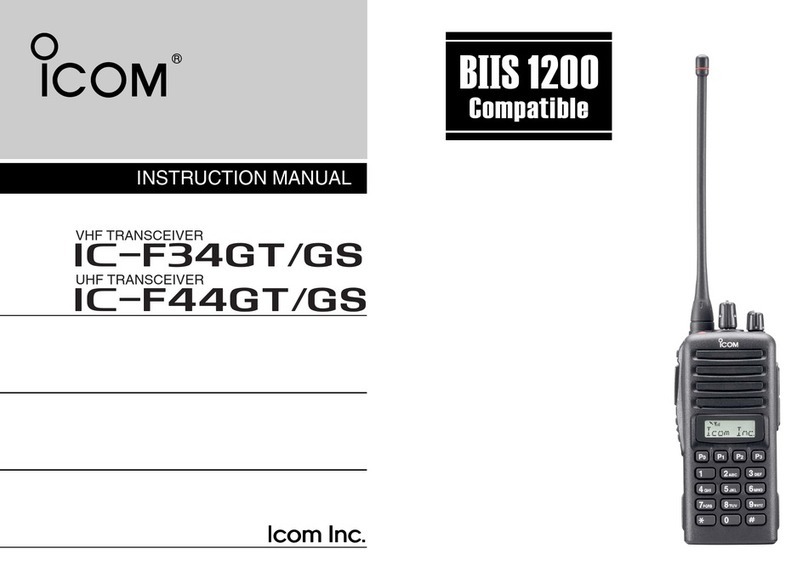
Icom
Icom IC-F44GS User manual
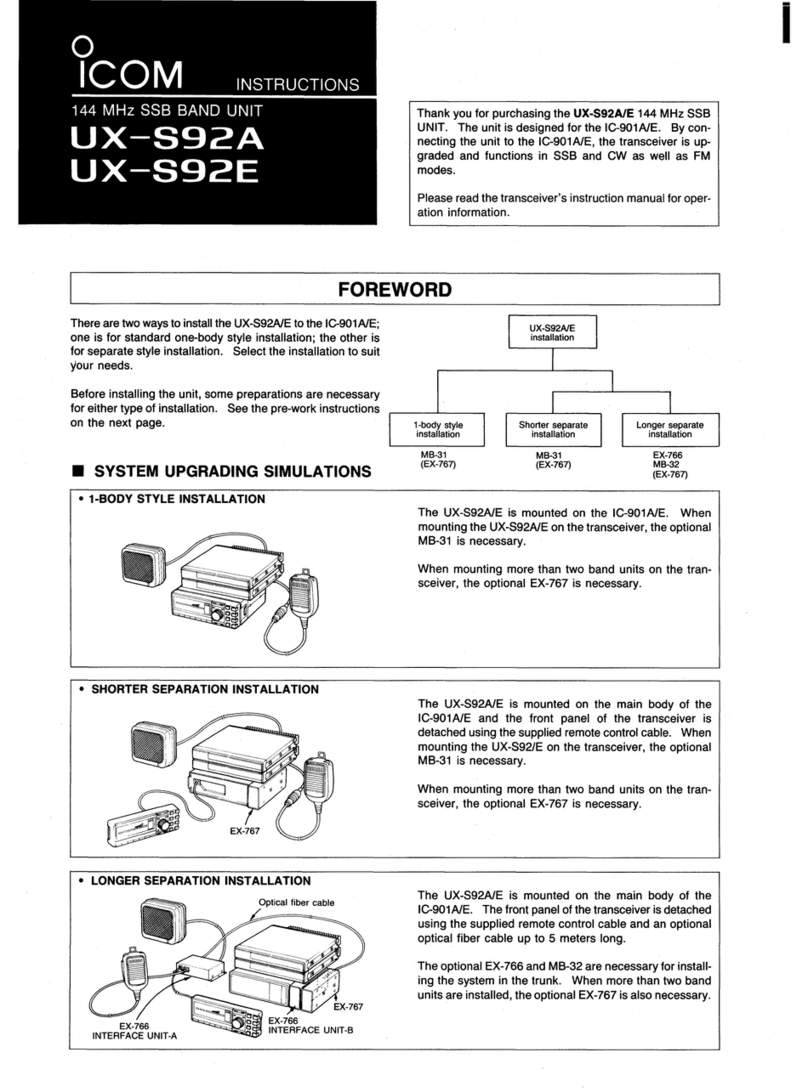
Icom
Icom UX-S92A User manual
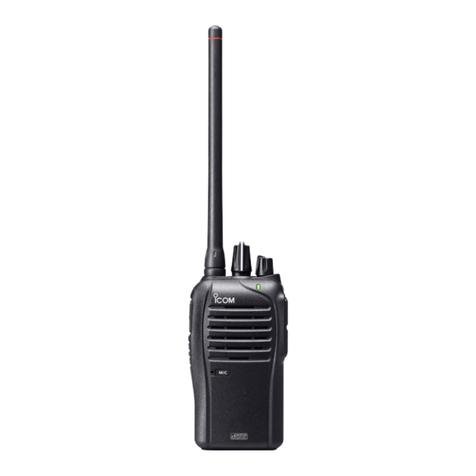
Icom
Icom iDAS IC-F3103D User manual
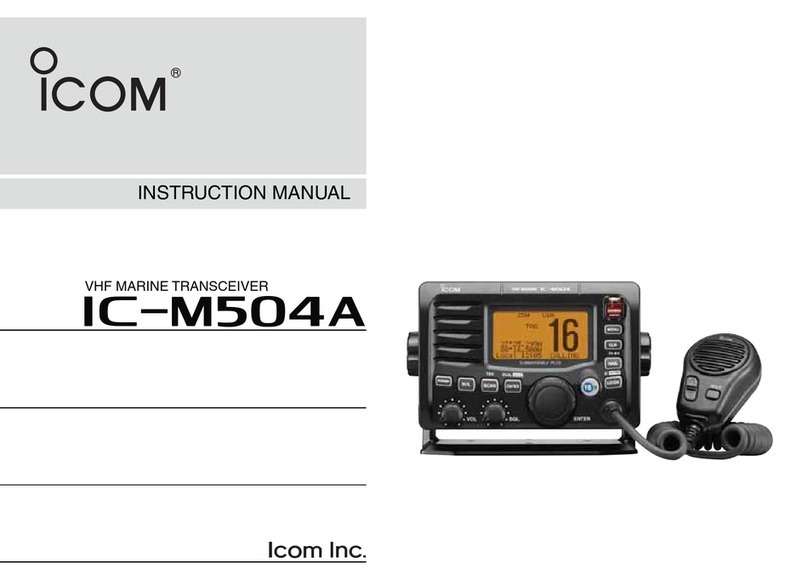
Icom
Icom IC-M504A User manual

Icom
Icom IC-M604 User manual
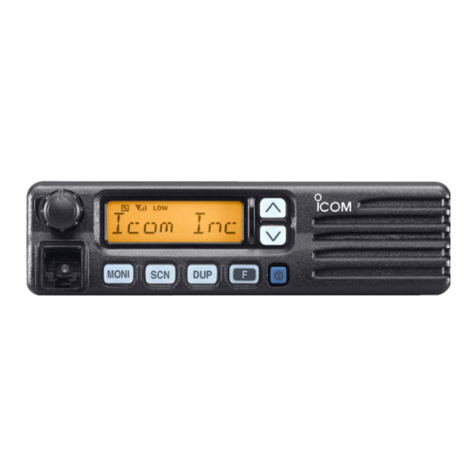
Icom
Icom IC-400PRO User manual
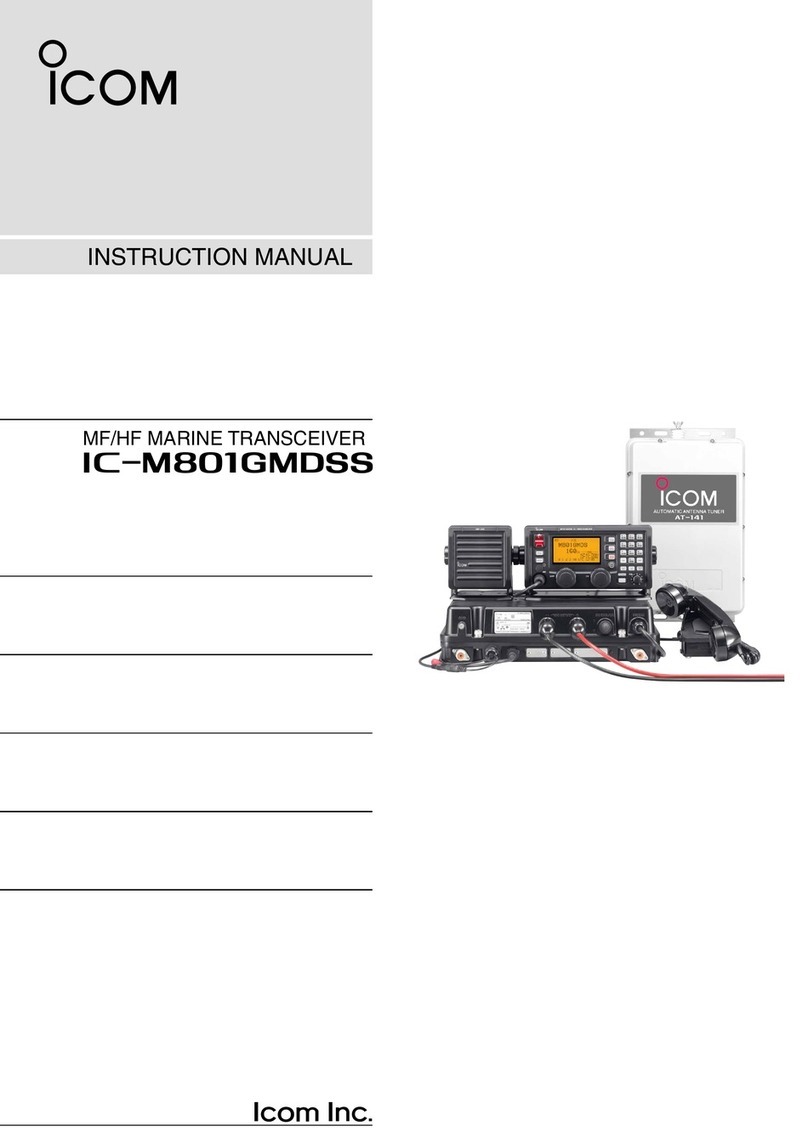
Icom
Icom IC-M801GMDSS User manual
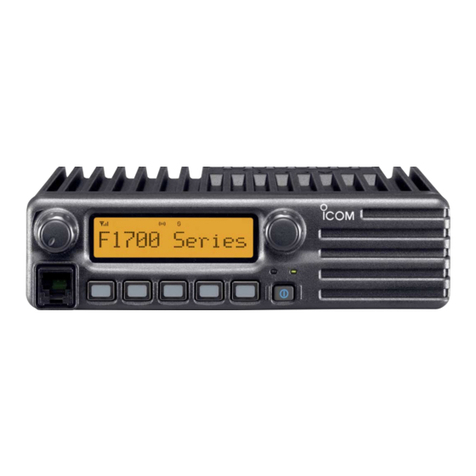
Icom
Icom IC-F1821D User manual
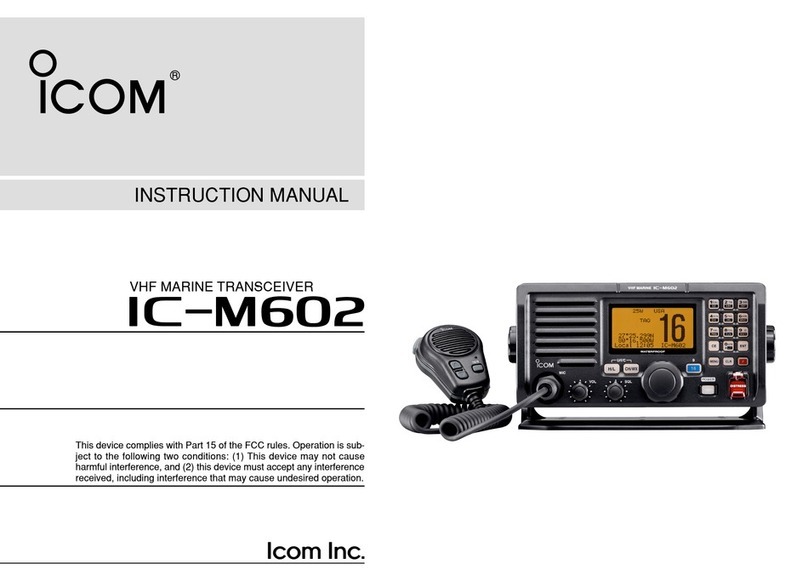
Icom
Icom IC-M602 User manual
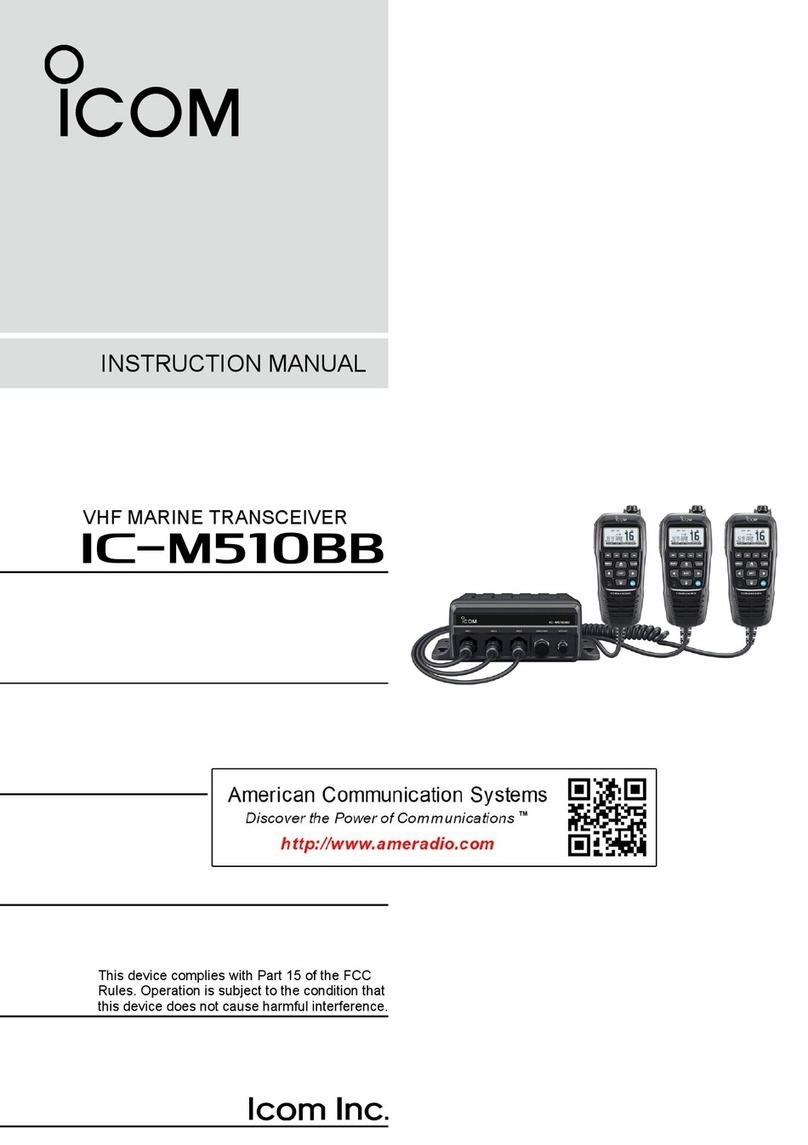
Icom
Icom IC-M510BB User manual

Icom
Icom IC-2200H User manual

Icom
Icom IC-24AT User manual
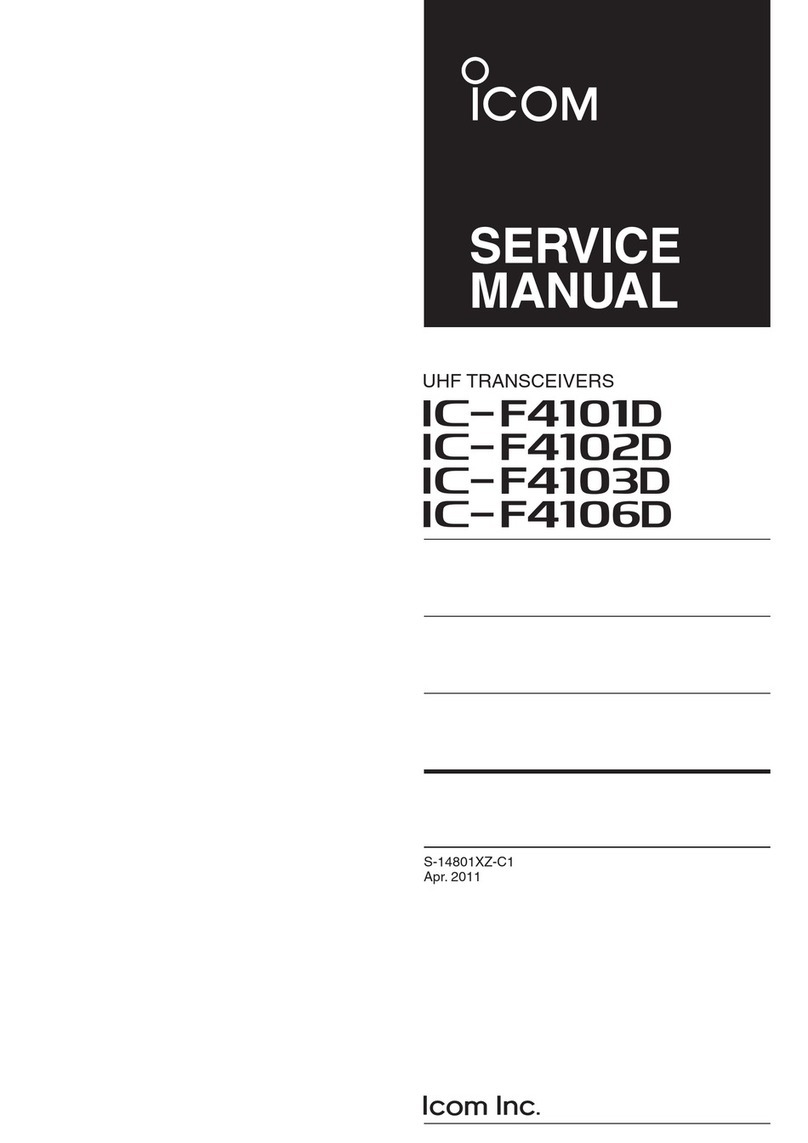
Icom
Icom IC-F4101D User manual
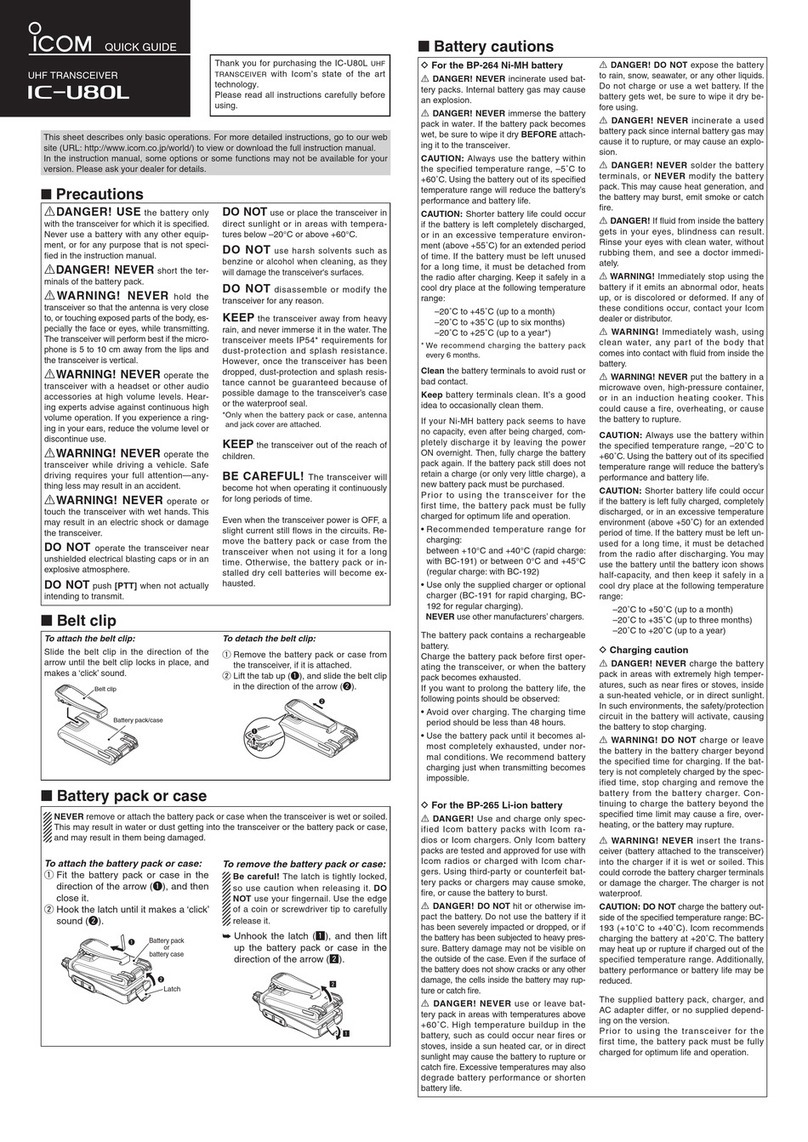
Icom
Icom IC-U80L User manual
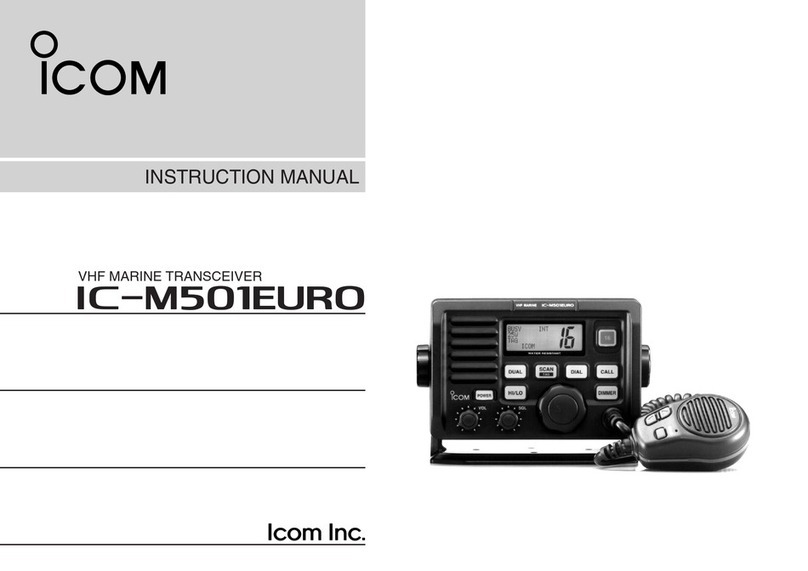
Icom
Icom VHF MARINE TRANSCEIVER IC-M501EURO User manual
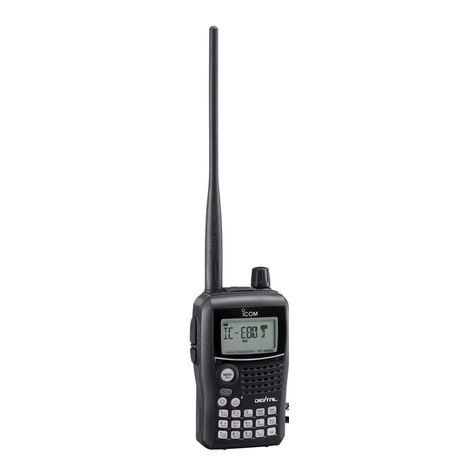
Icom
Icom IC-E80D User manual
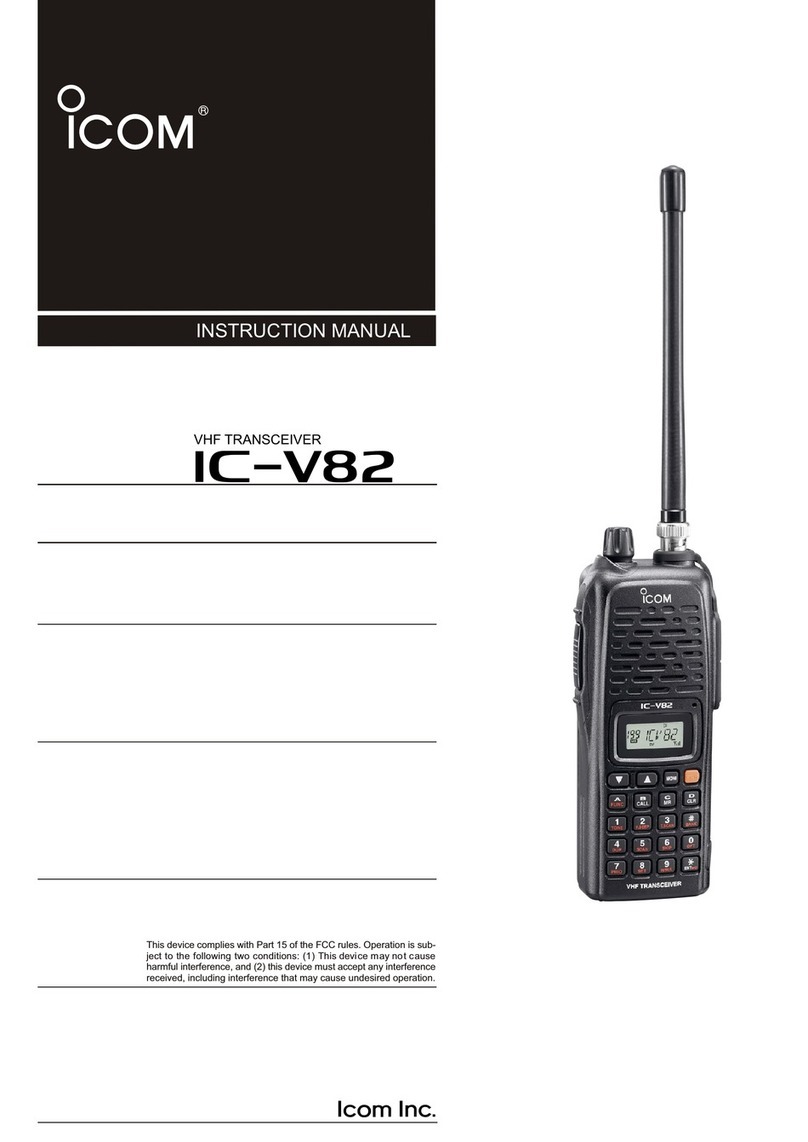
Icom
Icom IC-V82 User manual
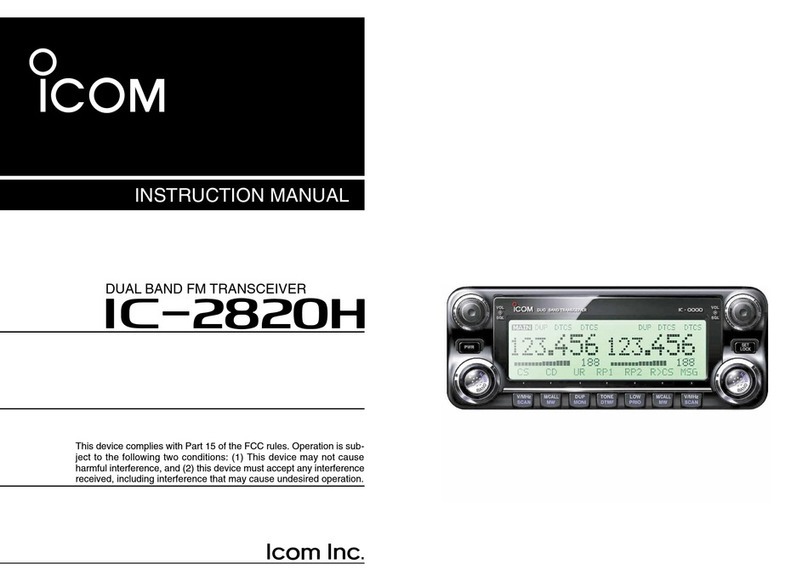
Icom
Icom IC-2820H User manual
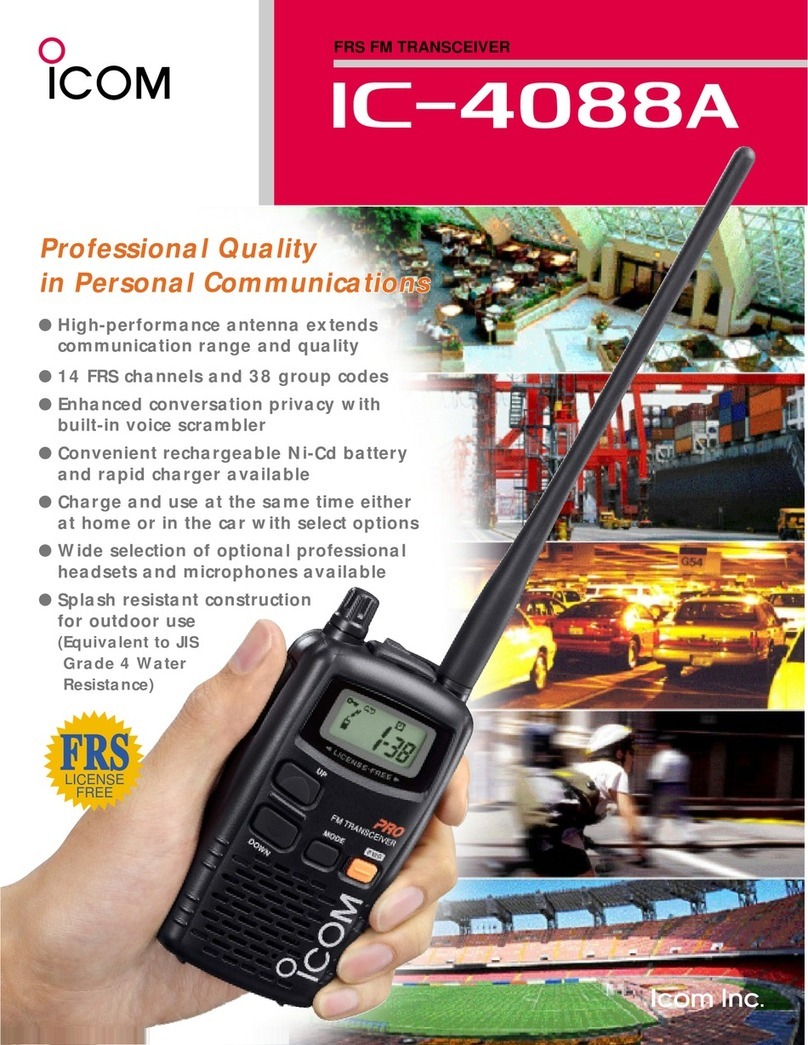
Icom
Icom IC-4088A User manual
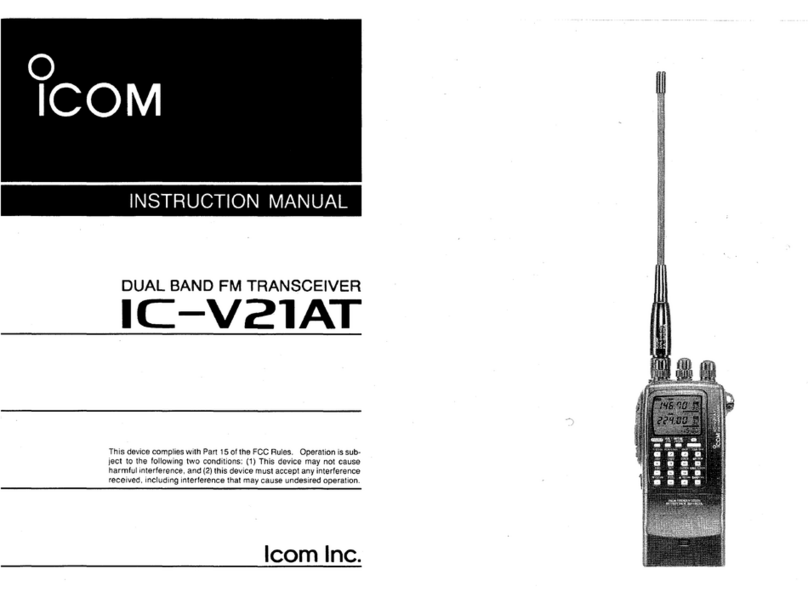
Icom
Icom IC-V21AT User manual
